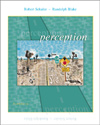| achromatic system | In the opponent-process view of color vision, the pathway that generates and transmits information about an object's lightness. See chromatic system.
|
 |
 |
 |
| additive color mixture | A color that results when several component colors are combined in such a way that each component contributes a portion to the spectral composition of the combination. See subtractive color mixture.
|
 |
 |
 |
| brightness | The dimension of color experience related to the amount of light emitted by an object. See hue, saturation.
|
 |
 |
 |
| chromatic system | In the opponent-process view of color vision, the pathway that generates and transmits information about an object's color. See achromatic system.
|
 |
 |
 |
| color constancy | The tendency of an object's color to remain unchanged despite changes in the spectrum of light falling on--and reflected by--that object.
|
 |
 |
 |
| color contrast | A change in color appearance brought about by juxtaposing particular color pairs.
|
 |
 |
 |
| color deficiency | In humans, a departure from normal trichromatic color vision; takes various forms, including anomalous trichromacy, dichromacy, and monochromacy.
|
 |
 |
 |
| complementary | Describing two colors that can be mixed to form white.
|
 |
 |
 |
| composite light | According to Newton, any light that is made up of several different color components. See pure light.
|
 |
 |
 |
| dichromatic | Referring to a person whose eye contains two types of cone photopigments.
|
 |
 |
 |
| discrimination | The process by which one object is distinguished from another.
|
 |
 |
 |
| habituation | The process by which an organism ceases to respond to some stimulus.
|
 |
 |
 |
| hue | The dimension of color experience that distinguishes among red, orange, yellow, green, blue, and so on; the dimension of color most strongly determined by light's wavelength; commonly used as synonym for color. See brightness, saturation.
|
 |
 |
 |
| identification | The process of distinguishing a particular object.
|
 |
 |
 |
| microspectrophotometry | A technique for measuring, at various wavelengths, the quantity of light reflected or absorbed by a small object; used to measure cone photopigments.
|
 |
 |
 |
| monochromat | A person whose eye contains just one type of cone photopigment.
|
 |
 |
 |
| neutral point | In a dichromatic eye, the wavelength of light that appears white (neutral in color).
|
 |
 |
 |
| Newton's color circle | A geometric arrangement of colors summarizing the results of mixing varying amounts of different colors.
|
 |
 |
 |
| nonspectral colors | Colors, such as purple, that are not found in the spectrum.
|
 |
 |
 |
| pure light | According to Newton, any light that cannot be broken down into constituent colors. See composite light.
|
 |
 |
 |
| saturation | The dimension of color experience that distinguishes pale or washed-out colors from vivid colors. See brightness, hue.
|
 |
 |
 |
| spectral colors | Hues that are present in a spectrum created by diffracting white light as, for example, in a rainbow.
|
 |
 |
 |
| subtractive color mixture | A color produced when each of a number of components absorbs a portion of the light's spectrum, thereby subtracting that portion from the reflected spectrum. See additive color mixture.
|
 |
 |
 |
| trichromatic | Referring to a person whose eye contains three types of cone photopigments.
|
 |
 |
 |
| univariance principle | The hypothesis that any photoreceptor's response corresponds to just a single variable, the amount of light absorbed; because photoreceptors obey the univariance principle, the wavelength characteristics of light that stimulate a photoreceptor are not directly represented in the receptor's response.
|
 |
 |
 |
| Young-Helmholtz theory | The theory that human color vision is trichromatic--that is, it depends on the responses of three types of cones.
|



 2002 McGraw-Hill Higher Education
2002 McGraw-Hill Higher Education

 2002 McGraw-Hill Higher Education
2002 McGraw-Hill Higher Education